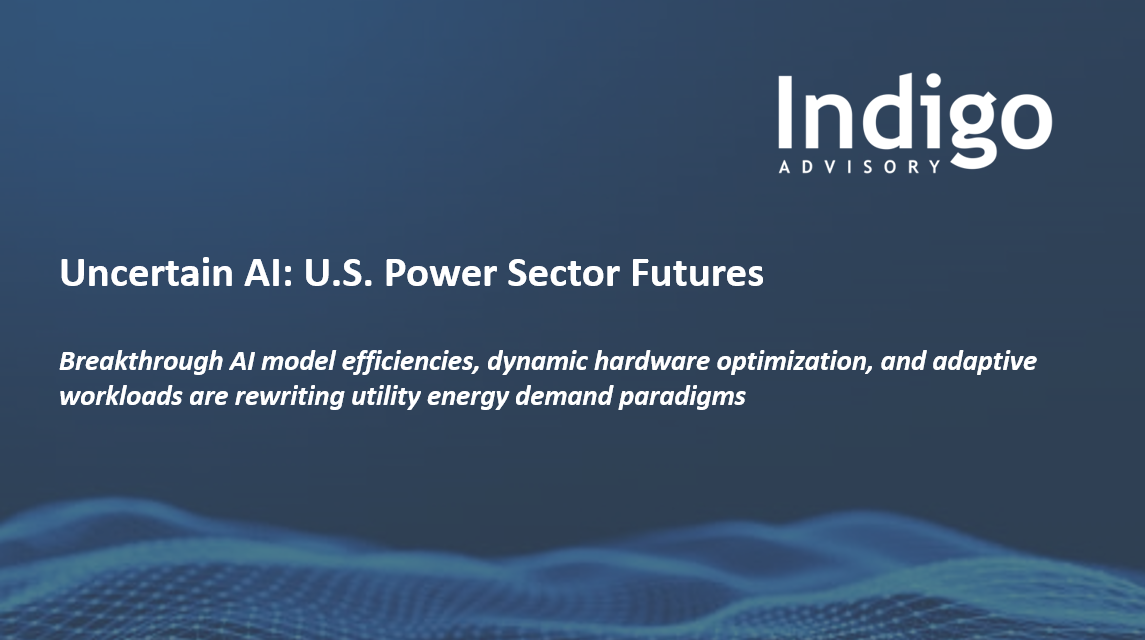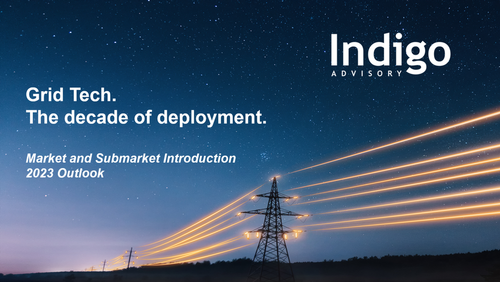
Market Intelligence and research for a dynamic energy technology landscape.
In an era of rapid industrial change, our research is focused on helping power companies and the broader energy industry develop the right strategies. From emerging business models, to commercially available technologies, our insights help industry executives make the least regrets and most forward looking decisions. Below are examples of a cross section of reports, market briefs and analysis.
Report: Indigo & Latitude Intelligence - Utility AI Insights
A new technological age is underway in the power sector. Utilities, tasked with playing a leading role in how the economy decarbonizes, are increasingly looking for digital solutions to complicated problems. The magnitude of complexity is staggering — manage an energy and technology transition while maintaining the imperative of resiliency, reliability, and affordability. But improved sector digital maturity, buoyed by the availability of multi-modal data, is helping to meet an uptick in weather events, distributed energy resource (DER) deployments, and evolving customer needs. Increasingly, sophisticated artificial intelligence solutions and software are advancing the energy transition.
In this report we assess how the power sector is presently evaluating and adopting AI and explore the solutions that may impact its future. To paint this picture, this report examines both the supply side and the demand side of the Utility AI market. Through interviews with multiple utility leaders, the assembly of numerous data sets, and by leveraging on the ground deployment experience, the research offers unique insight into the space. This report ultimately serves as a temperature check, opportunity guide, and a capability forecast for a rapidly changing sector. Learn more.
Uncertain AI: 2030 U.S. Power Sector Futures
The US power sector faces a $1-2T grid modernization challenge through 2030, with AI reshaping 15-25% of investment decisions. The sector stands at a critical crossroads between two fundamentally different futures: massive hyperscale AI clusters driving fixed transmission needs, or dynamic, decentralized AI loads reshaping grid edge capabilities.
Mapping these competing pathways reveals four distinct scenarios. In transmission-centric futures, single AI clusters demand 300-2000 MW per location, with up to 80% of load concentrating in just five markets. Distribution-centric paths see smaller facilities (1-50MW) enabling more flexible power deployment, with edge computing claiming up to 70% of workloads.
In this uncertain landscape, emerging AI breakthroughs that cut energy use by up to 50x could completely reshape these projections. Tech giants are already transforming this landscape. From AWS's $150B infrastructure commitment to Microsoft's TerraPower partnership, traditional energy procurement strategies are being rewritten. AI workloads are projected to command 10-80% of data center compute, putting $80-180B of utility transmission and distribution infrastructure investments at stake. Learn more.
Grid Tech Research Series: The Decade of Deployment
The multibillion-dollar Grid Tech and software market enables utility decarbonization, investment deferral, and improved customer satisfaction. Our analysis of submarkets forecasts the sector to be worth $641 billion by 2030, with a CAGR of over 19%. The market, which is generation source agnostic in the main, is comprised of several stakeholders. On the one hand, you have a broad set of utilities, with various ownership structures and other buyers who have experienced decades of changing physical grid requirements and evolving regulatory frameworks. On the other hand, a range of suppliers ranging from conglomerates, specialized mid-sized companies and startups are innovating and integrating sophisticated solutions into new and existing product sets. This is all underpinned by a rapidly growing climate VC market, substantial amounts of public money and new standalone business models that are enabling new economic arrangements to quickly spread throughout the industry.
As we enter into the ‘Decade of Deployment’ for clean technologies and as public and private finance ramps up, analyzing this market as a whole becomes a necessity. The last round of significant public funding, over a decade ago, paved the way for a robust Smart Grid market while simultaneously an evolving regulatory structure enabled a bourgeoning Grid Edge market. The economic impact of that stimulus was significant and has formed the technical foundation for future upgrades.
This article is the first in an introductory three-part series that overviews the market, explain the submarket dynamics, and focus on the future of the market and how new technologies are enabling rapid change. The research also profiles the top solution providers in the space via the Grid Tech 150. This series is accompanied by a complementary Grid Tech introductory report.
Indigo & EPRI Blockchain Market Intelligence Report
Indigo partnered with the the Electric Power Research Institute (EPRI) on a first of a kind blockchain report that features results and insights from 15 utilities and one regional transmission operator (RTO) across the US and Europe. Although 70% of respondents believe the utility blockchain market is still emerging, there is a great deal of activity in the space with several utilities conducting pilots, developing proof of concepts, and encouraging internal research. As we enter a more mature phase of understanding of the technology in the energy and utilities sector this report serves as a “temperature gauge” of adoption.
Utilities surveyed included: Burlington Electric Department, Centrica, Con Edison, DTE Energy, EDF, Enel, EON Climate and Renewables, Exelon, Hawaiian Electric, National Grid Partners, New York Power Authority, Pacific Gas & Electric, Southern Company, Tennessee Valley Authority and Tuscon Electric Power.
The work builds on the Blockchain Consortium for New York’s Joint Utilities spearheaded by Indigo. The successful initiative aligned the State’s Power Companies on the level of impact and possible applications of the technology. Read more here on the joint utilities work, download the EPRI and Indigo report here. A summary infographic of the work is also available.
Further Resources
Download our capability primer - "Transformation Tools for Utilities - digital strategies, analysis and approaches to lead the energy transition", checkout our review of Digitization in the Power Sector, “The Digital Utility - Capabilities, Applications and Core Components”, explore our dedicated Blockchain Resource Center, and see our latest market perspectives on our intelligence center, Indigo Insights.





